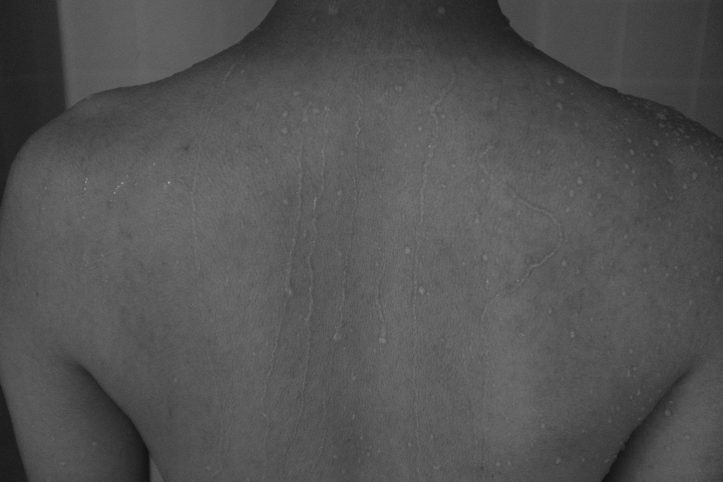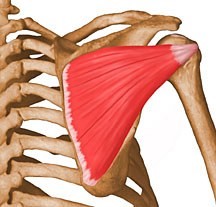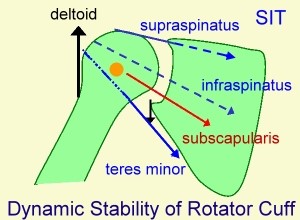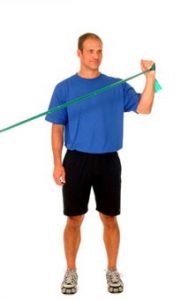

Therapist Blog by Jim Norris (PT, DPT)
The rotator cuff is a group of four muscles surrounding the shoulder. The rotator cuff complex consists of the supraspinatus, infraspinatus, teres minor, and subscapularis muscles. Each of these muscles play an important role in maintaining stability of the glenohumeral (GH) joint. Additionally, they assist with controlling the direction, degree, and quality of motion of the humeral head during upper extremity movements, which is required for optimal shoulder function to occur.1 This article will focus on the importance of the infraspinatus muscle, which is part of the posterior rotator cuff along with the teres minor.
*Note: The humerus is the bone that articulates with the glenoid fossa of scapula and gives rise to the shoulder joint, hence glenohumeral joint.
The infraspinatus originates on the medial border (closer to spinal column) of the scapula, specifically from the infraspinous fossa. Its tendon (attachment point of the muscle to a bony surface) passes posteriorly to the glenohumeral joint to insert on the greater tubercle (a bony landmark) of the head of the humerus. The infraspinatus is most commonly known for its role as the primary external rotator of the GH joint. An example of this motion is opening a door.
Another essential role of this muscle is to provide a compressive and inferior (downward) force that stabilizes the humeral head during overhead movements, which includes counteracting the superior translatory force of the deltoid. The infraspinatus is also active during transverse abduction of the shoulder such as throwing a frisbee.

Due to the line of pull of the infraspinatus, it is more effective as an external rotator at lower shoulder abduction angles (keeping arm closer to the side of your body). The increasing angle during abduction decreases the moment arm of the infraspinatus, which decreases the amount of external rotation force.2 Although the infraspinatus is less effective at higher abduction angles, it acts to stabilize the shoulder during overhead activities such as throwing and washing your upper back and hair in the shower.
How is the Infraspinatus Injured?
The most common injuries to the infraspinatus muscle are tendinitis (or tendinopathy) and a tear of the tendon. Tendinitis is an inflammation of the tendon which usually is a result of repetitive overhead reaching, pushing, or lifting with outstretched arms. Athletes who perform overhead activities such as swimming, tennis, throwing, golf, weightlifting, volleyball, and gymnastics, are also at risk.3 Tears in the tendon can be partial or full, and may be the result of either an acute injury or degeneration (breakdown) of the muscle over a period of time. An acute injury to the muscle can be caused by a fall, direct blow, or a rapid use of force (like pulling on a starter cable for a lawn mower). Also, it is not uncommon for an untreated tendinopathy to, overtime, result in a degenerative tear. Degenerative tears are more likely to occur when the muscle is unused and/or maintained in a stretched position over a period of time (for example, sitting with rounded shoulders). Because the muscle also acts to stabilize and compress the humeral head in the glenoid fossa, weakness may also lead to secondary issues including shoulder impingement.3
How to Protect Yourself from Injury

The best way to protect yourself from these injuries starts with proper body mechanics and posture. In today’s society, many people have jobs that require copious amounts of time spent sitting. Sitting makes it difficult to maintain an upright posture, causing the shoulders to round forward. This leads to a prolonged stretch of the infraspinatus that can also lead to weakness of the muscle. It is also worth noting that this poor posture is common due to the fact that the vast majority of our motions occur in front of us (such as typing, writing, and reading). Along with postural training, is it critical to strengthen the infraspinatus to allow proper functioning of the muscle, which includes providing dynamic stability and producing external-rotation torque at the shoulder joint.4
Exercises to Prevent/Rehabilitate
There are several different exercises commonly used to strengthen the shoulder external rotators. Reinold et al used EMG (electromyography) signals to find what exercises are most effective for strengthening the infraspinatus muscle for both injury prevention and rehabilitation. The following three exercises were found to be the best at activating the muscle.5
*Note EMG (Electro-Myography) is used to detect and measure muscle activity
1. Side-lying External Rotation (ER)
- To exercise the right side, begin lying on your left side, with the right shoulder pointing towards the ceiling
- Place a towel under the armpit and a pillow or cushion under your head to prevent straining the neck.
- Retract (squeeze together) the shoulder blades and maintain throughout exercise.
- Keep the elbow by the side and flexed to about 90 degrees.
- Make a fist or hold a light weight, and externally rotate towards the ceiling
- Control motion back down
- 2-3 sets of 10-15 repetitions
2. Standing ER in the scapular plane (45 degrees abduction)

- In standing, start with the arm at by the side and elbow flexed to 90 degrees.
- Hold onto a light resistance band or low weight with a cable column
- Band/weight should be set around waist height
- Maintaining elbow flexion, abduct arm to 45 degrees, and then bring elbow forward slightly into scaption plane (pictured above)
- Maintaining position of elbow and arm, externally rotate the shoulder
- 2-3 sets of 10-15 repetitions
3. Prone ER 90 degrees abduction
- Lay face down on top of a table and one shoulder at the edge.
- Keep elbow bent at 90 degrees, and abduct shoulder so the elbow is in line with your shoulder (90 degrees)
- Use either no weight or a light dumbbell
- Maintaining elbow flexion, lower the arm down into a comfortable starting position, and then externally rotate towards the ceiling
- 2-3 sets of 10-15 repetitions
4. T-band Rows
- Wrap a t-band band around a pole or any immovable object at belly button height.
- Hold on to both ends of the band so that there is equal length on each side, while also keeping tension in the band at the starting position
- Begin with elbows extended with an upright trunk (maintained throughout), and then pull elbows straight back, keeping the elbows close to to the side
- Retract shoulders while pulling band back (imagine trying to squeeze a dollar bill between your shoulder blades)
2-3 sets of 10-15 repetitions
References
- http://digitalrepository.unm.edu/cgi/viewcontent.cgi?article=1023&context=dpt
- http://www.exrx.net/Muscles/Infraspinatus.html
- https://www.uptodate.com/contents/rotator-cuff-tendinitis-and-tear-beyond-the-basics
- Ha, S., Kwon, O., Cynn, H., Lee, W., Kim, S. and Park, K. (2013). Selective Activation of the Infraspinatus Muscle. Journal of Athletic Training, 48(3), pp.346-352.
- Reinold MM, Escamilla R, Wilk KE. Current Concepts in the Scientific and Clinical Rationale Behind Exercises for Glenohumeral and Scapulothoracic Musculature. Journal of Orthopaedic & Sports Physical Therapy. 2009;39(2):105-117. doi:10.2519/jospt.2009.2835.
